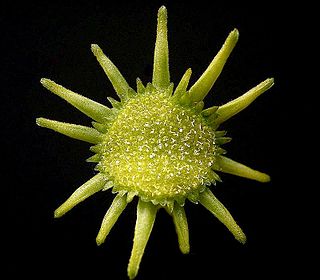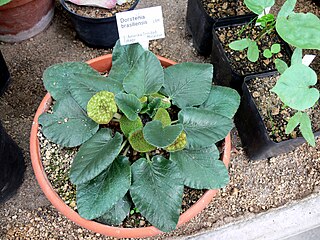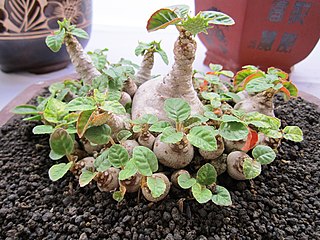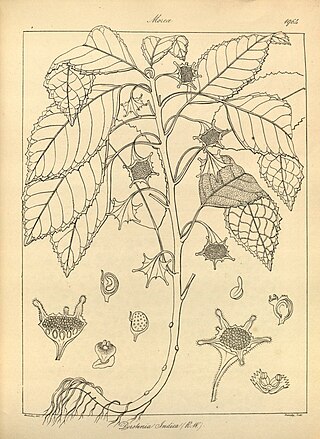
The Moraceae—often called the mulberry family or fig family—are a family of flowering plants comprising about 38 genera and over 1100 species. Most are widespread in tropical and subtropical regions, less so in temperate climates; however, their distribution is cosmopolitan overall. The only synapomorphy within the Moraceae is presence of laticifers and milky sap in all parenchymatous tissues, but generally useful field characters include two carpels sometimes with one reduced, compound inconspicuous flowers, and compound fruits. The family includes well-known plants such as the fig, banyan, breadfruit, jackfruit, mulberry, and Osage orange. The 'flowers' of Moraceae are often pseudanthia.

Contrayerva, or contrajerva, is the medicinal rhizome of various tropical Central American and South American species of Dorstenia in the family Moraceae, mainly Dorstenia contrajerva and the closely related Dorstenia drakena but also Dorstenia brasiliensis. The word contrayerva means “counter herb” in Spanish. It was given this name since a 16th-century description claimed that the leaves of a herb were used by South American Indians to counter the deadly poisonous effect of the same herb when used as an arrow poison. Seventeenth century herbalists and botanists identified this herb as the aromatic root that had been brought from Peru to England by Francis Drake, and claimed that it was an antidote against all kinds of poison. By the late 18th century contrayerva had lost its reputation as an antidote, but it continued to be listed in European and American pharmacopoeias and herbals until the 1920s as a gentle stimulant, tonic and diaphoretic. It is still used in folk medicine in Central and South America.
This is a list of plants which includes trees and other herbs, vines, climbers, lianas, shrubs, subshrubs that are native or endemic, found in Cuba.

Gardenia mannii, the nānū, Oahu gardenia or Mann's gardenia, is a species of flowering tree in the coffee family, Rubiaceae, that is endemic to the island of Oʻahu in Hawaiʻi. It inhabits coastal mesic, mixed mesic, and wet forests at elevations of 100–730 m (330–2,400 ft) in the Koʻolau and Waiʻanae Ranges. It is threatened by habitat loss.

Cucumeropsis mannii is a species of melon native to tropical Africa west of the East African Rift, where it is grown for food and as a source of oil.

Dorstenia is a genus within the mulberry family, Moraceae. Depending on the author, there are said to be 100 to 170 species within this genus, second only in number to the genus Ficus within Moraceae. Dorstenia species are mainly known for their unusual inflorescences and growth habits. Dorstenia is named in honor of the German physician and botanist Theodor Dorsten (1492–1552). The type species is Dorstenia contrajerva.
Dorstenia aristeguietae is a plant species in the family Moraceae which is native to Venezuela.

Dorstenia elata is a plant species in the family Moraceae.

Dorstenia contrajerva is a plant species in the family Moraceae. It is native to Northern South America and Central America, and is cultivated elsewhere. The species name "contrajerva" is the Latinized form of the plant's Spanish name, "contrahierba", a name for plants used for treating poisoning and venomous bites and stings, and for which its rootstocks are used in folk medicine. It is the type species of the Dorstenia genus and was first described by Carl Linnaeus in 1753.

Dorstenia brasiliensis is a species of herbaceous plant in the family Moraceae of the order Rosales.
Dorstenia flagellifera is a plant species in the family Moraceae which is native to Haiti.
Dorstenia belizensis is a plant species in the family Moraceae which is native to Belize.
Dorstenia nummularia is a plant species in the family Moraceae which is native to Cuba.
Dorstenia peltata is a plant species in the family Moraceae which is native to the Dominican Republic and Cuba.

Prenylated flavonoids or prenylflavonoids are a sub-class of flavonoids. They are widely distributed throughout the plant kingdom. Some are known to have phytoestrogenic or antioxidant properties. They are given in the list of adaptogens in herbalism. Chemically they have a prenyl group attached to their flavonoid backbone. It is usually assumed that the addition of hydrophobic prenyl groups facilitate attachment to cell membranes. Prenylation may increase the potential activity of its original flavonoid.

Dorstenia gigas is a species of flowering plant in the Moraceae family. It is a succulent native to the Socotra Islands off the Horn of Africa.

Rauvolfia mannii grows as a shrub or small tree up to 8 metres (26 ft) tall. Its fragrant flowers feature white to pink or red-brown, or yellow corolla lobes. Its habitat is forests from sea level to 2,500 metres (8,200 ft) altitude. The plant has been used as arrow poison. Rauvolfia mannii is native to central Africa.

Dorstenia foetida, also known as grendelion, is a succulent plant in the genus Dorstenia, which is native to Eastern Africa and Arabia. It is a very variable species with a wide distribution.

Dorstenia indica is a small plant species in the family Moraceae native to Southern India and Sri Lanka. It was first described by Robert Wight in 1853.












